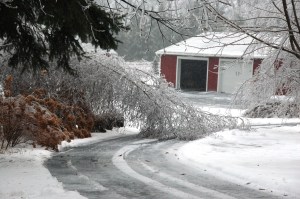Our normally mild corner of the country got hit early and hard with cold weather a few weeks ago. For several days straight, our home thermometer read anywhere from 22-25F. Now, Seattle routinely gets temperatures this low sometime during the winter. But this cold spell came very early – much earlier than our regionally adapted trees and shrubs were used to. The effect on our plants was significant.
 Rhodies react to cold but tolerate the freezing temperatures
Rhodies react to cold but tolerate the freezing temperatures
Trees and shrubs start getting ready for dormancy in the summer. They key in on the progressively shorter days and make biochemical preparations that are unnoticeable. When the first frosty evenings arrive, leaf color changes begin immediately. Chlorophyll, proteins and sugars are scavenged and stored in trunks and roots – we see leaves change from green to red, orange, yellow, and eventually brown. Slowly an abscission layer is laid down at the base of the leaf petiole, and when the layer is complete the leaf dies and falls.
But this year the trees weren’t ready. It got cold really fast, and green leaves died on the trees. And they are still there. Eventually these old leaves will fall, though some of them may stay on until spring.
 Both the hydrangea in the foreground and the styrax in the back have retained their leaves after the cold snap.
Both the hydrangea in the foreground and the styrax in the back have retained their leaves after the cold snap.
What does this mean in terms of tree health? Well, it won’t kill them, but it does set them back in terms of food storage. A lot of the nutrients that were still in the leaves when they froze are lost to the tree. So there may not be as many reserves for winter root growth, or for spring leaf flush. Overall, we could expect to see less than normal growth in established trees and shrubs.





























